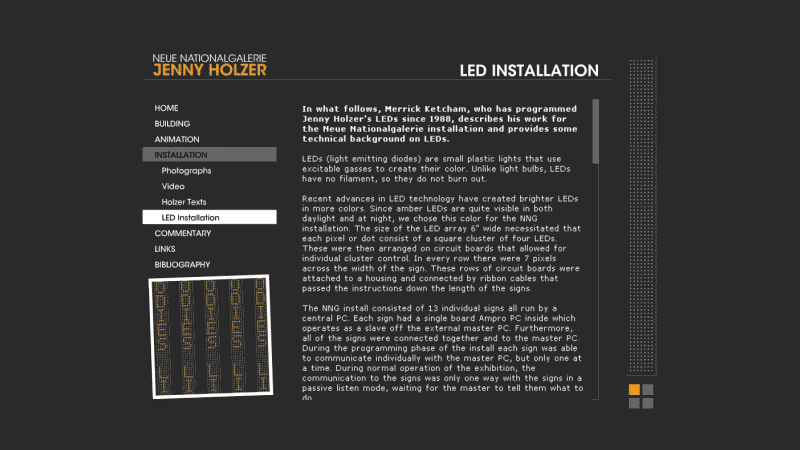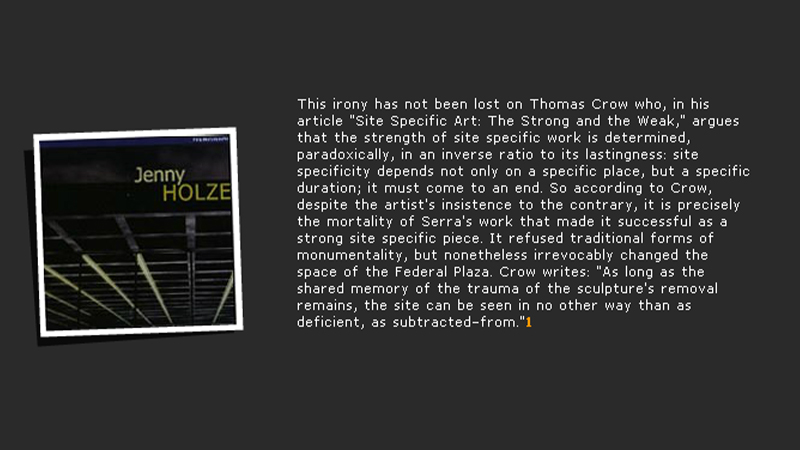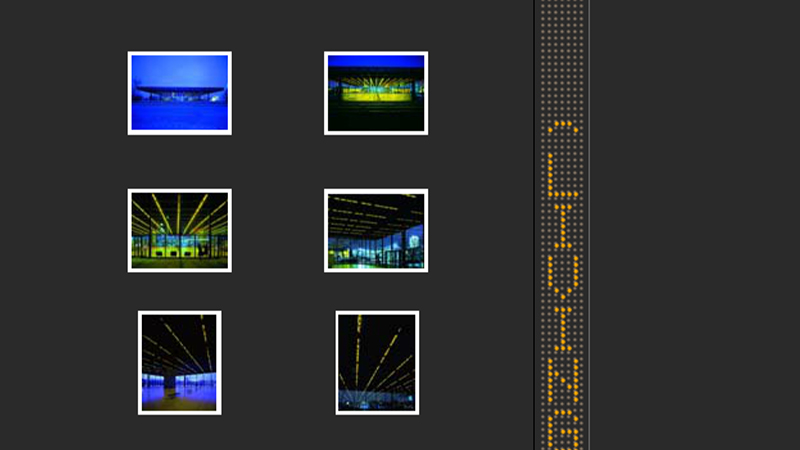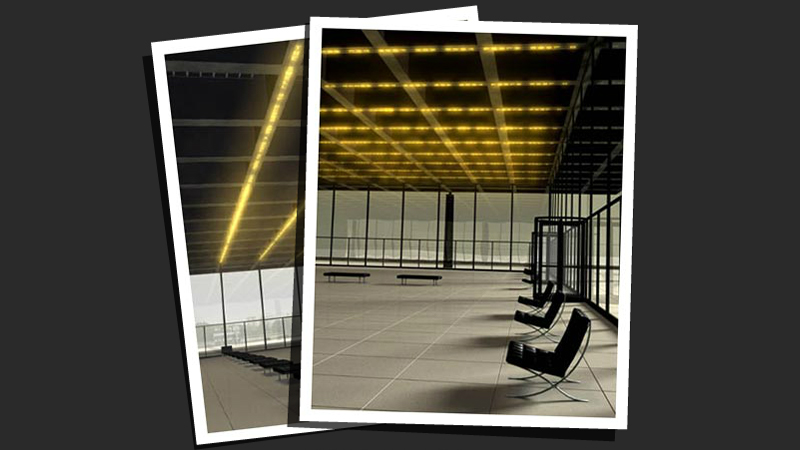Editor's Introduction
"Jenny Holzer's signature LED statements scroll past in an instant, commanding the reader's attention lest the moment be lost. These flickering screens are deeply meaningful experiments in time-based media, animating text long before the past decade's explosion of software packages made screen movement seem inevitable. They are also environmental media, specific to the places they inhabit; we might understand them as early investigations into ubiquitous computing, particularly given the labor-intensive programming required to realize any single LED work. Jenny Holzer at the Neue Nationalgalerie [is] a multi-perspectival documentation of a specific exhibition at a precise moment in space and time.
Combining video, animation, scholarly essays, photographs, and a wealth of other information, the project at one level functions as a multimedia catalog or database, deploying many forms of media to 'preserve' the inherently ephemeral experience of the art exhibition. This kind of 'thick description' allows multiple points of entry into both the Neue Nationalgalerie exhibit and into Holzer's work more generally.
But Jenny Holzer at the Neue Nationalgalerie does more than simply present evidence that this exhibition did indeed happen. Like all of the projects in this first issue of Vectors, it also implies an argument about the relationship between evidence and interface. In selecting what perspectives and artifacts would be included and in deciding how to structure access to these elements, the project privileges modes of presentation in dialogue with contemporary scholarship in performance studies, art history, and cultural studies. In detailing the sustained and collaborative labor involved in the construction of Holzer's LEDs, the piece reminds us of the often-invisible work that underlies our experiences of media and of art, something much less obvious to the visitors immersed in the dreamy modernists spaces of the original installation. In that regard, it shares with The Stolen Time Archive a precise goal: the desire to always remember the material in our engagements with the ephemeral." – Tara McPherson and Steve Anderson, Vectors Editors
Author's Statement
"Why
Jenny Holzer, why a retrospective at Berlin's Neue Nationalgalerie, why
an electronic journal, and why all three coming together in Vectors' inaugural issue devoted to 'evidence'? Framing an answer brings to mind some phrases from Holzer's signature early work, Truisms.
First: 'DESCRIPTION IS MORE VALUABLE THAN METAPHOR.' Like all of Holzer's
truisms, some rhetorical seduction and sleight-of-hand are at work here.
The phrase sounds so authoritative; it seems to compel assent; it must
be true. But what's the context? Is the statement really a
self-evident absolute truth; or is it only true in specific instances?
What is missing is deixis, the extralinguistic indication of
evidence that would allow you, the addressee of the phrase, to figure
out the reference, context, and truth-value of the supposed truism.
Seen
from one perspective, I think this truism actually says a lot about how
Gwen Allen and I, the organizers of this project, tried to proceed
methodologically. In the website, we place a premium on pointing. We
like the indexical gesture, the gesture that simply points at the
evidence and says to the reader: here is what it is, now you need to
contextualize it, to put your own signature on it. It also seems to us
that multimedia documentation is particularly useful for making an
indexical gesture. In lieu of having to use a 1000 words to describe a
picture of the Holzer installation, we can present a photograph,
animation, or video and then be able to say, 'here, take a look.'
But
there is, ultimately, a limit to the usefulness of just pointing. Or,
perhaps more precisely, there is a limit to the idea that one can simply
point and do nothing else. Basically, pointing presupposes framing.
Another way to say this is that description always implies metaphor, and
metaphor always implies description. One cannot describe without
selecting out certain things to describe. Description is always from a
perspective. As a result, it is always comparative to other
perspectives. Metaphor is comparison, and to the extent that any
pointing and describing requires a comparative theory for selecting what
to point at and describe, description entails metaphor. Pointing
already entails interpretation. Evidence is not simply what is seen;
evidence is what is pulled out of the whole field of the seen and shown
to be important. Ex + videre = out of + to see. Ironically, a 1000 words are sometimes more important than a single picture.
So
. . . in designing the Holzer site, we had to deal with the question of
how our pointing at and framing of evidence, i.e. our interface,
implies an interpretation of that evidence.
Another truism: 'A
SINGLE EVENT CAN HAVE INFINITELY MANY INTERPRETATIONS.' Again, we
tried to take this to heart. We asked a whole variety of contributors,
all from slightly different backgrounds, to offer different lenses on
how to perceive Holzer's work at the Nationalgalerie. And rather than
treat one lens as more important than another, we tried to be
egalitarian. Consequently our interface does not demand that a visitor
read one person's response before another. There is no single way that a
person has to go through the site. So while the use of multimedia
evidence allows us to privilege the gesture of pointing, the hyperlinked
structure of the web allows us to de-privilege a hierarchical structure
of argument.
But there is a catch to this truism as well.
Although a single event can have infinite interpretations, that does not
actually mean that each one of them is equally valid. I do believe
that all of the interpretations of Holzer's installation offered on our
site are valid and, perhaps, equally valid. But saying that does not
mean we were able to extricate ourselves from making some hierarchical
choices. There actually is a hierarchical organization implied in the
interface of our menu bar. One way to interact with the site is simply
to move progressively down the menu bar from the 'Home' to the 'Bibliography.' Doing so offers the visitor a more or less
chronological sense of how the installation at the Neue Nationalgalerie
was conceived, worked out in the planning stages, installed, received,
and finally archived. The web may aspire to be free-floating; the
interactivity of the web may aspire to put as much interpretive power on
the side of the receiver as on that of the sender; but there is
structure. The infinity of possible interpretations is a closed
infinity, rather than an open one.
And yet . . . 'DON'T PLACE TOO
MUCH TRUST IN EXPERTS.' Please do not think that a chronological
approach is an authoritative approach. As Gwen Allen makes clear in her
critical essay about the exhibition, digital technology in particular
and technologies of reproduction in general complicate the relative
natures of past, present, and future. That quasi-truism is one of the
theses about evidence that this site attempts to make manifest.
We
believe we've given you enough evidence to trust our interpretations.
Whether we have is, in the end, at least one interpretation left to you."
-- Ehren Fordyce, from Vectors, Volume 1, Issue 1, Fall 2005
Designer's Statement
"My goal as designer/programmer was to build a site that served as a virtual record, a interactive documentary snapshot, of Holzer's installation at the Berlin Neue Nationalgalerie. The site features a clean, functional interface that is both easy to use and attuned to Holzer's and Mies Van Der Rohe's modernist aesthetics. The site is also dynamically driven and therefore scalable; content can be modified, added or removed with relative ease as new information or scholarly research becomes available. -- Alessandro Ceglia
Alessandro was born in Milan, Italy and educated in the U.S. He received his B.A. from Dartmouth College in Art History and Asian Studies, and then spent five years abroad in various parts of Asia and Europe. He returned to the U.S. in 2001 to work as an interactive designer and developer. He is now based in Los Angeles, and continues to work on interactive projects while pursuing an M.F.A. in animation and digital art at USC's School of Cinema-Television." -- from Vectors, Volume 1, Issue 1, Fall 2005
Project Credits
"Installation Texts
Jenny Holzer
LED Engineering
Paul Miller
LED Programming
Merrick Ketcham
Initial Conception of the Web Project
Ehren Fordyce and Rebecca Groves
Principal Editors
Gwen Allen and Ehren Fordyce
Initial Web Design
Adrian Graham, with Aaron Russell
Flash Redesign and Development and Flash LED interfaces
Alessandro Ceglia
Overview, Architecture, Interview with Greg Niemeyer, and Critical Essay
Gwen Allen
Author's Statement and Geography
Ehren Fordyce
Animation
Ben Dean and Greg Niemeyer
Installation Photographs
Attilio Maranzano
Installation Video
Claudia Miller
Text on LED Installation
Merrick Ketcham
Exhibition Review
Daniel Mufson
With
special thanks to Jenny Holzer for permission to publish the
installation texts; to the Neue Nationalgalerie for their assistance in
providing photographs and video of the exhibition; and to Tara
McPherson, Greg Niemeyer, and Jeffrey Schnapp for their support in
developing the project.
This project was initially produced by
dpResearch with financial and technical support from the Stanford
Humanities Lab and the Stanford Department of Drama and additional
support from the Institute for Multimedia Literacy." -- from Vectors, Volume 1, Issue 1, Fall 2005
1 COPY IN THE NEXT
Published in Fall, 2005 by Vectors in Volume 1, Issue 1.
This copy was given to the Electronic Literature Lab by Erik Loyer in November of 2021.
PUBLICATION TYPE
Online Journal
COPY MEDIA FORMAT
Web



